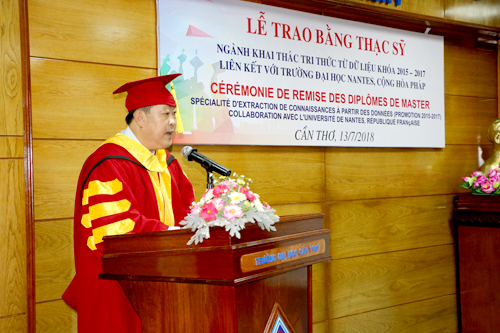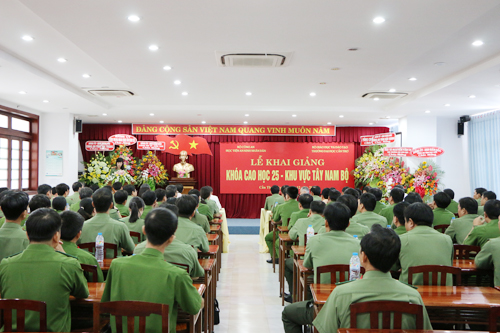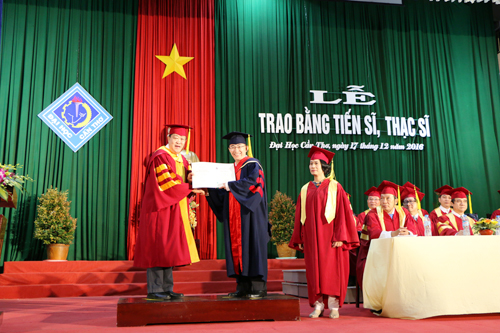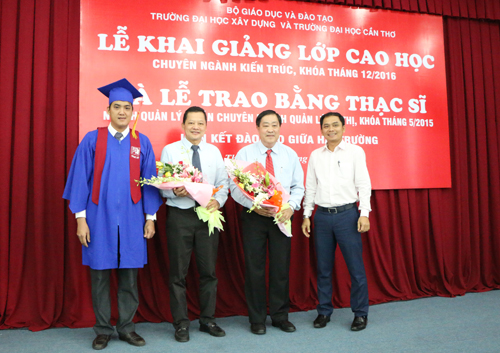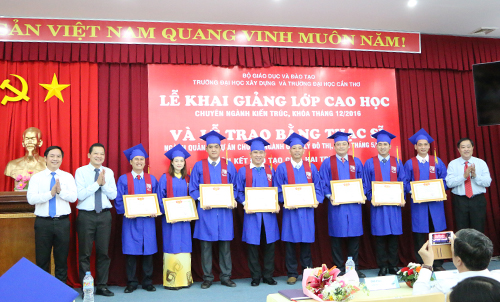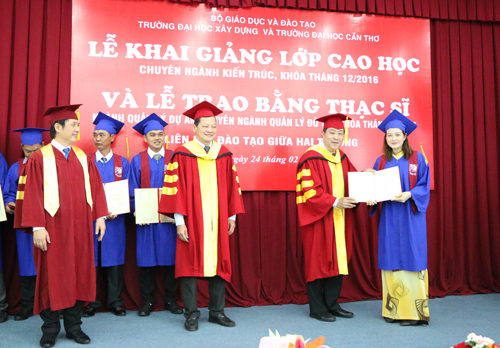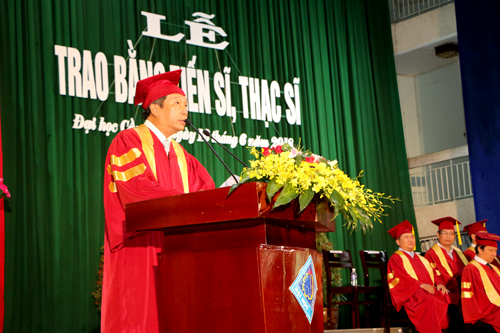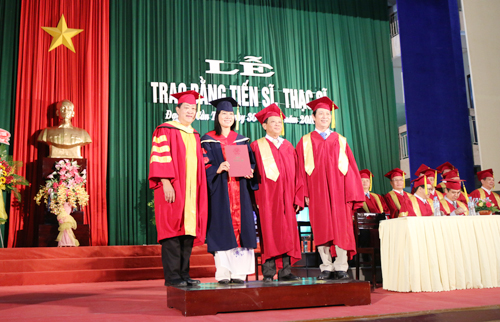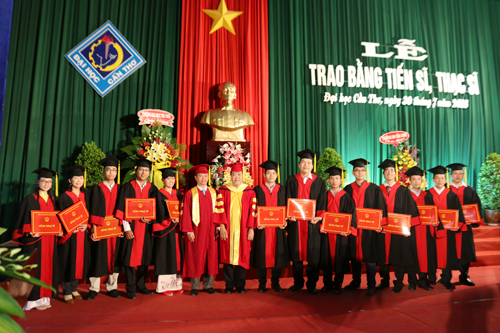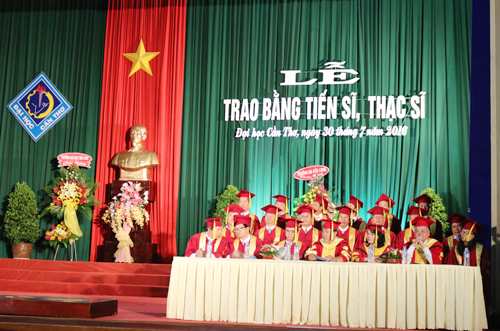
Tên đề tài: “Nghiên cứu và ứng dụng xạ khuẩn trong phòng trị bệnh héo rũ do nấm Fusarium sp. trên khoai lang”.
Tác giả: Nguyễn Văn Tập, Khóa: 2015
Chuyên ngành: Bảo vệ thực vật; Mã số: 62620110. Nhóm ngành: Nông, lâm nghiệp và thuỷ sản.
Người hướng dẫn chính: PGS.TS. Lê Minh Tường - Trường Đại học Cần Thơ
Người hướng dẫn phụ: TS. Nguyễn Đức Cương - Viện Lúa ĐBSCL
- Tóm tắt nội dung luận án
Nghiên cứu được thực hiện từ tháng 3 năm 2016 đến tháng 10 năm 2018 với các kết quả đạt được như sau:
Thu thập và phân lập được 10 dòng nấm Fusarium spp. gây bệnh héo rũ hại khoai lang tại các xã thuộc huyện Bình Tân, tỉnh Vĩnh Long. Dựa vào đặc điểm hình thái và đặc điểm sinh học cho thấy cả 10 dòng nấm phân lập đều thuộc Fusarium oxysporum. Mặt khác, các dòng nấm đều có khả năng gây bệnh trên cây khoai lang với triệu chứng điển hình của bệnh héo rũ và dòng nấm Fo.BT10 thể hiện khả năng gây hại nặng nhất trong tổng số 10 dòng nấm phân lập. Bên cạnh đó, trình tự gen vùng ITS của dòng Fo.BT10 có mức độ tương đồng với loài Fusarium oxysporum là 100%.
Thu thập phân lập được 120 chủng xạ khuẩn từ đất trồng khoai lang ở các xã thuộc huyện Bình Tân, tỉnh Vĩnh Long. Khả năng đối kháng của các chủng xạ khuẩn đối với nấm Fusarium oxysporum gây bệnh héo rũ hại khoai lang được thực hiện trong điều kiện phòng thí nghiệm. Kết quả cho thấy, có 28 trong tổng số 120 chủng xạ khuẩn thể hiện khả năng đối kháng với nấm Fusarium oxysporum và 5 chủng TTr4; TL8; TTh15; TL10 và TĐ7 thể hiện khả năng đối kháng cao thông qua bán kính vòng vô khuẩn lần lượt là 7,4 mm; 6,6 mm; 4,2 mm; 6,4 mm và 6,2 mm và hiệu suất đối kháng lần lượt là 64,2%; 56,0%; 46,4%; 53,3% và 45,2% ở thời điểm 5 ngày sau khi bố trí thí nghiệm. Khả năng ức chế sự mọc mầm và sự hình thành bào tử nấm Fusarium oxysporum của 5 chủng xạ khuẩn (TTr4, TL8, TTh15, TL10 và TĐ7) được thực hiện trong điều kiện phòng thí nghiệm với 4 lần lặp lại. Kết quả cho thấy, chủng TTr4 thể hiện khả năng ức chế sự mọc mầm và sự hình thành bào tử nấm cao với tỷ lệ bào tử mọc mầm thấp kéo dài đến thời điểm 24 giờ sau khi xử lý và mật số bào tử nấm hình thành thấp là 70,00 bào tử/ml ở thời điểm 7 ngày sau khi bố trí thí nghiệm. Ngoài ra, khả năng phân giải chitin của 5 chủng xạ khuẩn (TTr4, TL8, TTh15, TL10 và TĐ7) được thực hiện với 5 lần lặp lại. Kết quả cho thấy 3 chủng TTr4, TL8 và TTh15 thể hiện khả năng tiết ra enzyme phân giải chitin cao thông qua bán kính vòng phân giải lần lượt là 19,67 mm; 20,40 mm và 18,53 mm và hàm lượng enzyme chitinase tiết ra lần lượt là 107,80 IU/ml; 103,61 IU/ml và 55,44 IU/ml ở thời điểm 7 ngày sau khi bố trí thí nghiệm. Khả năng phân giải β-glucan của 5 chủng xạ khuẩn trên cũng được thực hiện với 5 lần lặp lại. Kết quả cho thấy 3 chủng TTr4, TL8 và TTh15 có khả năng tiết ra phân giải β-glucan cao thông qua bán kính vòng phân giải lần lượt là 15,80 mm; 12,80 mm và 11,13 mm và hàm lượng enzyme β-glucanase tiết ra lần lượt là 0,754 IU/ml; 0,678 IU/ml và 0,682 IU/ml ở thời điểm 14 ngày sau khi bố trí thí nghiệm.
Khả nảng phòng trừ bệnh héo rũ trên khoai lang của 3 chủng xạ khuẩn (TTr4, TL8 và TTh15) được thực hiện trong điều kiện nhà lưới với 5 lần lặp lại. Kết quả cho thấy 3 chủng xạ khuẩn thí nghiệm khi được xử lý kết hợp ở thời điểm 2 ngày trước và 2 ngày sau khi lây bệnh nhân tạo cho tỷ lệ bệnh thấp lần lượt là 25,0%; 48,0% và 48,0%; chỉ số bệnh thấp lần lượt là 21,5%; 44,0% và 41,0% và hiệu quả giảm bệnh cao lần lượt là 75,0%; 52,0% và 52,0% ở thời điểm 10 ngày sau khi lây bệnh nhân tạo.
Ba chủng xạ khuẩn (TTr4, TL8 và TTh15) được định danh dựa vào đặc điểm hình thái, đặc điểm sinh hoá và giải trình tự gen vùng 16S-rRNA. Kết quả quan sát đặc điểm hình thái và đặc điểm sinh hóa cho thấy 3 chủng xạ khuẩn thí nghiệm thuộc chi Streptomyces và khi so sánh trình tự gene vùng 16S-rDNA của ba mẫu xạ khuẩn trong nghiên cứu này với các trình tự sẵn có trên ngân hàng gene (GenBank) cho thấy rằng mẫu TTr4 là loài Streptomyces bacillaris với mức tương đồng là 99%; mẫu TL8 là loài Streptomyces lavendulae với mức tương đồng là 99% và mẫu TTh15 là loài Streptomyces violaceoruber với mức tương đồng là 99%.
Đánh giá khả năng phòng trị bệnh héo rũ hại khoai lang của 2 chủng xạ khuẩn TTr4 và TTh15 trong điều kiện ngoài đồng tại ấp Tân Trung, xã Tân Bình, huyện Bình Tân, tỉnh Vĩnh Long được thực hiện 2 vụ từ tháng 11/2017 đến tháng 10/2018. Kết quả cho thấy 2 chủng xạ khuẩn TTh15 và TTr4 đều có khả năng quản lý bệnh héo rũ do nấm Fusarium oxysporum ở điều kiện ngoài đồng. Nghiệm thức được xử lý kết hợp ở giai đoạn 20 NSKT + 40 NSKT + 60 NSKT của chủng TTr4 cho khả năng quản lý bệnh héo rũ cao hơn và khác biệt ý nghĩa thống kê so với đối chứng và tương đương với nghiệm thức xử lý thuốc hóa học. Mặt khác, các nghiệm thức được xử lý xạ khuẩn không làm ảnh hưởng đến sự phát triển về chiều dài và số chồi dây khoai lang. Đồng thời, các nghiệm thức được xử lý chủng xạ khuẩn TTh15, TTr4 ở giai đoạn 20 NSKT + 40 NSKT + 60 NSKT cho năng suất cao tương đương so với nghiệm thức xử lý thuốc hóa học.
- Những kết quả mới của luận án
- Xác định loài nấm Fusarium oxysporum gây bệnh héo rũ hại khoai lang tại huyện Bình Tân, tỉnh Vĩnh Long.
- Xác định được 3 chủng xạ khuẩn TTr4, TL8 và TTh15 có khả năng phòng trị bệnh héo rũ do nấm Fusarium oxysporum gây hại trên khoai lang ở điều kiện nhà lưới.
- Khả năng đối kháng của 3 chủng xạ khuẩn TTr4, TL8 và TTh15 đối với nấm Fusarium oxysporum gây bệnh héo rũ trên khoai lang có liên quan đến khả năng tiết enzyme chitinase và enzyme β-glucanase.
- Xác định được loài của 3 chủng xạ khuẩn triển vọng là: TTr4 là loài Streptomyces bacillaris; TL8 là loài Streptomyces lavendulae và TTh15 là loài Streptomyces violaceoruber.
- Tuyển chọn được 2 chủng Streptomyces bacillaris (TTr4) và Streptomyces violaceoruber (TTh15) có khả năng quản lý bệnh héo rũ hại khoai lang ở điều kiện ngoài đồng.
- Các ứng dụng/khả năng ứng dụng trong thực tiễn, các vấn đề cần tiếp tục nghiên cứu
3.1 Các ứng dụng/khả năng ứng dụng trong thực tiễn
Kết quả của luận án cung cấp những thông tin về nấm Fusarium oxysporum gây bệnh héo rũ hại khoai lang ở huyện Bình Tân, tỉnh Vĩnh Long, đồng thời cũng đã xác định được các chủng xạ khuẩn có khả năng phòng trị bệnh ở đieèu kiện ngoài đồng. Từ kết quả nghiên cứu này, làm cơ sở cho những nghiên cứu sau nhằm tìm ra sản phẩm sinh học có nguồn gốc từ xạ khuẩn góp phần bổ sung vào quy trình phòng trừ dịch hại trên khoai lang vừa hiệu quả, vừa thân thiện với môi trường
3.2 Các vấn đề cần tiếp tục nghiên cứu
Tiếp tục nghiên cứu khả năng phòng trị bệnh héo rũ khoai lang của các chủng xạ khuẩn triển vọng ở những địa phương khác và trên giống khoai lang khác
Nghiên cứu quy trình sản xuất chế phẩm sinh học có nguồn gốc từ xạ khuẩn nhằm cung cấp rộng rãi chế phẩm này đến nông dân canh tác khoai lang ở huyện Bình Tân, tỉnh Vỉnh Long nói riêng và nông dân canh tác khoai lang ở Đồng bằng sông Cửu Long nói chung.
Thesis title: Research and application of actinomycetes isolates in the Fusarium wilt disease caused by Fusarium sp. on sweet potato
Major: Plant Protection Major code: : 62620112
Full name of student: Nguyen Van Tap
Advisor: Assoc. Prof. Dr. Le Minh Tuong and Dr. Nguyen Duc Cuong
Institution: Can Tho University
- Thesis summary
The study was carried out from March 2016 to October 2018 with the following results:
There were 10 Fusarium spp. strains that were collected in some villages of Binh Tan district, Vinh Long province. The samples were determined based on morphological and biological characteristics. The results showed that all 10 strains belonged to Fusarium oxysporum species. Beside, they induced typical symptoms of Fusarium wilt disease on Sweet Potato and the Fo.BT10 strain was high pathogenicity in 10 strains testing. On the other hand, the gene sequence of the ITS region of Fo.BT10 train showed 100% similarity with Fusarium oxysporum strain.
One hundred and twenty actinomycetes isolates were collected from Sweet Potato field in some villages of Binh Tan district, Vinh Long province. The antagonistic ability against Fusarium oxysporum fungus of these actinomyces isolates were determined in laboratory condition. The results showed that 28 of 120 isolates in total presented antagonistic activity against Fusarium oxysporum and 5 isolates, TTr4, TL8, TTh15, TL10 and TĐ7 showed higher stabler antagonistic ability with radiuses of inhibition zones reach 7.4 mm; 6.6 mm; 4.2 mm; 6.4 and và 6.2 mm and antagonistic efficacy of 64.2%; 56.0%; 46.4%; 53.3% và 45.2% respectively at 5 days after co-culture. The ability of inhibiting conidia germination and inhibiting sporulation of Fusarium oxysporum by 5 actinomycetes isolates (TTr4, TL8, TTh15, TL10 and TĐ7) was examined in laboratory condition with 4 replications. The resultes indicated that TTr4 isolate have the highest inhibition effecicacy with the lowest rate’s conidia germination at 24 hour after inoculation and the lowest conidia concentration reaches 70.00 at 7 days after testing. Chitinase activity of 5 actinomycetes isolates, TTr4, TL8, TTh15, TL10 and TĐ7 was performed with five replicates. The result indicated that, 5 actinomyces isolates had the chitinolytic activity and 3 isolates, TTr4, TL8 and TTh15 showed the highest chitinolytic activity with the chitin lyse halo radius of 19.67mm, 20.40 mm and 18.53 mm and dose of chitinase reach 107.80 IU/ml; 103.61 IU/ml and 55.44 IU/ml reach at 7 days after testing. Beside, the testing β-glucanase productivity of these actinomycetes was conducded with 5 replications. The resultes found that 3 isolates TTr4, TL8 and TTh15 showed the highest β-glucanolytic activity with the β-glucan lyse halo radius of 15.80 mm; 12.80 mm và 11.13 mm and dose of β-glucanase reach 0.754 IU/ml; 0.678 IU/ml and 0.682 IU/ml at 14 days after testing.
The biocontrol ability of 3 actinomycete isolates (TTr4, TL8 and TTh15) was tested in the nethouse condition. The results indicated that 3 isolates TTr4, TL8 and TTh15 which were applied twice (2 days before and 2 days after pathogen inoculation) gave the highest ability to control the disease through three criteria: low ratio of disease incidence was 25.0%, 48.0% and 48.0%; low disease index was 21.5%, 44.0% và 41.0% and high efficiency of disease reduction was 75.0%, 52.0% and 52.0% at 10 days after testing on sweet potato in nethouse condition.
Three actinomyces TTr4, TL8 and TTh15 isolates were identified based on morphological and biochemical characteristics. In addition, the these isolates were also identified based on the 16S-rRNA gene sequence. The results showed that 3 isolates TTr4, TL8 and TTh15 belongs to Streptomyces genus. Beside, comparison of the 16S-rDNA gene sequence with existing on Gene bank indicated that TTr4 isolate showed 99% similarity with Streptomyces bacillaris isolate, TL8 isolate showed 99% similarity with Streptomyces lavendulae isolate and TTh15 isolate showed 100% similarity with Streptomyces violaceoruber isolate.
Investigation of the ability of 2 isolates TTr4 and TTh15 to control the Fusarium wilt disease on Sweet potato in field condition. The experiment was carried out 2 seasons from November 2017 to October 2018 in Tan Trung hamlet, Tan Binh commune, Binh Tan district, Vinh Long province. This experiment was performed as a randomized completely block design with 18 treatments with 4 replications. The results showed that two actinomycetes isolates, TTh15 and TTr4 were able to control Fusarium wilt disease on Sweet potato in field condition. The treatments was applied by TTr4 isolates at 20 and 40 and 60 DAP that have the ability to control Fusarium wilt disease on Sweet potato and were significantly different compared with the control treatment and were not significantly different compared with the chemical treatment. The using actinomycetes had not affected the planting of the Sweet potato by the shoot lengh and the shoot number. On the other hand, the treatments was applied by TTr4 isolates at 20 and 40 and 60 DAP that showed the high of yield and were significantly different compared with the control treatment and were not significantly different compared with the chemical treatment.
- The new results of the dissertation
- Determination of Fusarium oxysporum causing Fusarium wilt on sweet potatoes in Binh Tan district, Vinh Long province.
- Three actinomycetes isolates including TTr4, TL8, and TTh15 have been identified that have the ability to prevent Fusarium wilt disease on sweet potatoes caused by Fusarium oxysporum under greenhouse conditions.
- The biocontrol ability of 3 actinomycetes TTr4, TL8 and TTh15 against Fusarium oxysporum causing Fusarium wilt disease on sweet potato was related to the ability to secrete chitinase and β-glucanase enzymes.
- Three actinomycetes isolates such as TTr4, TL8, and TH15 belongs to Streptomyces bacillaris, Streptomyces lavendulae, and Streptomyces violaceoruber, respectively.
- Two isolates of Streptomyces bacillaris (TTr4) and Streptomyces violaceoruber (TTh15) had ability to prevent Fusarium wilt disease on sweet potato under field conditions.
- The practical applications of this study and issues that need further investigate
3.1 The practical applications
The results of the thesis provided information about Fusarium oxysporum causing Fusarium wilt disease of sweet potatoes at Binh Tan district, Vinh Long province. Beside, the thesis informated that the actinomycete isolates had the ability to prevent Fusarium wilt disease on sweet potatoes under field conditions. The results of this study would serve as a basis for the following studies to find out biological products derived from actinomycetes that contribute to the pest control process on sweet potatoes that are both effective and friendly to the environment.
3.2 The issues that need further investigate
Determine the prevention of promising actinomycetes to Fusarium wilt disease at other localities and on other sweet potato varieties.
Study on the production process of probiotics derived from actinomycetes in order to widely supply this product to farmers who plant sweet potato at Binh Tan district, Vinh Long province in particular and the Mekong Delta in general.
- Xem chi tiết nội dung luận án
- Xem thông tin đăng tải tại Website Bộ giáo dục và Đào tạo. (Nhập tên NCS vào ô tìm kiếm)





